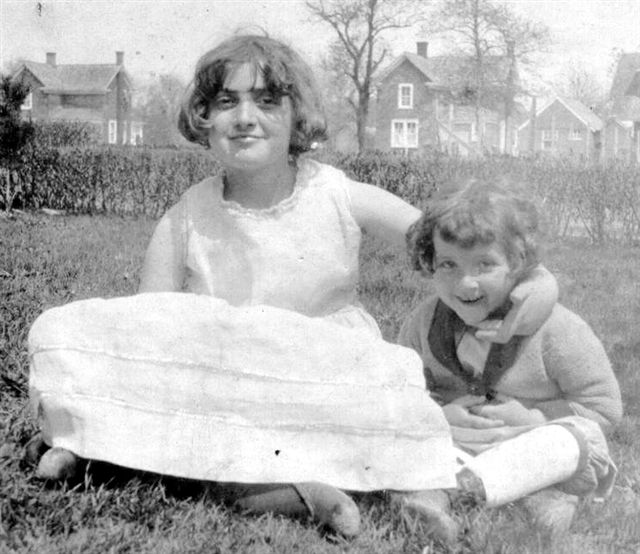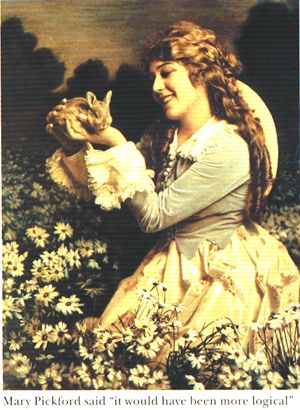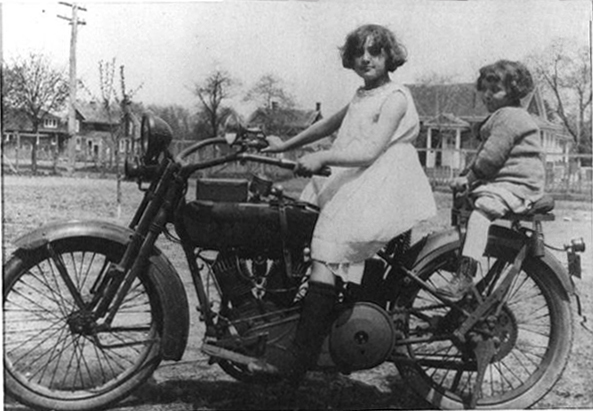
The
Freda
Follender
Audio file of Freda reading
this story
Before World
War II there was sea and sand, great marshes and endless stands of pine and oak
on the south
The
rich had discovered East Islip in the latter half the nineteenth century and in
my time their properties sprawled along the waterfront of the Great South Bay,
up into the marshes and beyond to
the south side of the only highway, Merrick Road. Their imposing homes were
hidden behind high stone walls or hedges to ensure privacy.
In
the nineteen thirties, the East Islip I remember could have been as distant from
The north side
of the
Their
children, my peers, were first generation Americans. My friends' parents were
humble people whose only aspiration was a better quality of life. They were good
workers. They sent hard-earned money to relatives left behind in Eastern Europe
and the financial help allowed the relatives to live a little better in their
native land and, eventually, to emigrate to East Islip.
Our

Freda (right) and
Sister Nellie Follender on their front lawn, 2nd Avenue, 1923. Nellie
has her ballet shoes and dress on for this photo. There was a large
empty lot across the street. The houses in the background are on the next
street,
Mr.
L’Hommedieu (pronounced “lama-dew” by all the residents) was the street
cleaner. He walked back and forth, up and down
A stout jolly
little man, Mr. Carey, spent a lot of time looking out of the large front window
of his office, a small white building with a sign over the door that said,
“John Carey, Real Estate, Insurance, Notary Public;
I don’t think much property changed hands then. You could buy thirty
acres of pine bush on the outskirts of
The largest
building on Main Street was an oblong two-story building with a faux Greek
revival porch that had been, up until World War I, a movie house. It
was sold in 1918 to my parents who manufactured dolls' wigs. The doll-wig
manufacture was a specialized business that employed, during full production,
two dozen women and a few men. My father commuted to the original wig factory in
(Note: The name of the factory was THE FOLLENDER WIG
CORPORATION. It is referred to thusly in doll encyclopedias.
He created the
wigs that Mary Pickford wore in her movies and he fashioned the diamond-entwined
blonde braids that Mae West showed off in her stage production of Diamond Lil.
Mrs. Jesse Strauss, wife of the president of R.H. Macy department store
was one of his clients. Many New Yorkers of means wore wigs or hair-pieces that
were attached to their own hair to make the elaborate hairdos of the late
eighteen nineties and early nineteen hundreds. While my father supervised
the

The caretaker
of the factory in
I loved going
for the holy water, setting foot in church made me feel that I belonged. The
wood-shingled St. Mary’s Roman Catholic Church was painted stark white
and topped with a large gold cross; it was the showpiece of
I looked forward to that Saturday morning errand fetching the holy water. I recall the overwhelming feelings of wonder and fright and awe as sooon as I lugged open the heavy, intricately carved wooden door. The church was always empty except for someone practicing dolorous music on the organ. Around the altar there was crisp embroidered linen, glittering gold, rich color and a sweet herbal smell of scented burning wax. Like a field of narcissi in the wind, votive candles flickered in their recessed niche in the rear wall. If it was sunny outside, I’d first stand and watch the amorphous blue and green shapes reflected from the stained glass windows onto the polished wood of the ceiling, the floor and the pews. Then as I walked down the aisle I made a game of stepping within a different pattern of the red and green carpet that ran between the pews. Approaching the altar, I avoided looking at the polychrome figure of my friends’ Christ who suffered there on the cross because my schoolmates never hesitated to remind me that MY people had crucified him.
East Islip was mostly Catholic, there were no other religious buildings. Everyone attended church at least once a week. Widows, the elderly and a few supplicants never missed the daily mass. For most of the church-goers religion was manifested in prayer-by-rote on Sunday and the cloak of faith and devotion was discarded until the toll of the church bells reminded them of their obligation on the next day of rest. They were good people who helped a neighbor, who looked upon sexual deviates and drunks with compassion and kindness, who helped the poor and the sick, not in the name of religion but because, as they would remind the succored, it might happen to them.
Across and up Main Street from St. Mary’s, the drug store (nobody called it a pharmacy) was approached by three wide, high, concrete steps. Inside it was dim and had an air of mystery. Mr. Jerome, the druggist (no one knew what pharmacist meant or had heard the
word) Mr. Jerome was not friendly with his customers. There was no medical doctor in the little village up until the middle thirties and when he was consulted Mr. Jerome dispensed his potions with such a proprietary air that his patrons were more than a little in awe of him.
The drug store was the only place in the village where one encountered “the rich people”. They slipped out of their wood-grain sided station wagons and ran quickly up the steps and never greeted anyone. They came to discuss their hunting dogs that Mr. Jerome boarded in the kennels out back of his store. Those dogs barked and yelped and kept neighbors awake at night but no one dared to complain.
The drugstore always smelled of iodine and tincture of benzoin. It was lit by three green glass shaded lamps that were suspended from the gray pressed-tin ceiling. On one side of the store there were four glass-fronted cabinets displaying sickroom supplies and patent medicines. In front of the opposite wall stood a high marble-topped mahogany counter behind which Mr. Jerome dispensed sodas and ice cream. An ice cream cone cost five
cents, an ice cream soda fifteen. There was no Coca Cola or Seven-Up but one did look forward to climbing up onto one of the high wrought iron stools to have a root beer or a cream soda or a chocolate drink that the druggist mixed from a bottled syrup and carbonated water. He handed you one paper straw from behind the counter and you sat for a long time, sipping your drink and admiring yourself in the smoky mirror that extended the length of the wall that faced the counter.
You wouldn’t dream of ordering a sarsaparilla soda, a popular choice of the grownups, because the soda fountain served another function: those times your mother led you by a stiff arm to the counter and asked Mr. Jerome to serve you a sarsparilla and castor oil mix to help along nature’s function. After several threats by
Mamma and encouraging pleas by the druggist, the mix was gulped down and you were left with a churning stomach and a mucoid, oily aftertaste lining your mouth and sheathing your tongue. No wonder no one today has even heard of a drink called sarsaparilla.
I had one close friend, Mary. Her mother was a house maid and her father was a gardener on a “rich estate”. Their house near Main Street was a two-story white frame building with no indoor plumbing; instead there was a narrow, well-worn path to a small unpainted building beyond their chicken yard that was only a little wider and taller than its door. Inside there was a wooden seat with a large and a small hole cut into it and fastened to the wall by two large nails was an old Sears and Roebuck catalogue. It was printed in black and white on newsprint paper. This was their toilet and toilet paper.
Mary’s house had a dining room where no one ever ate and a parlor where no one ever sat. The family spent their precious free time in the kitchen. When her great-grandmother died, the undertaker (there were no “funeral directors” yet) hung a huge flowered wreath on the front door and the deceased was presented for three days and nights in Mary’s sparsely furnished parlor. Everyone in the village came to the house to pay respects to the flower- banked coffin. Afterward they went into the kitchen to drink
schnapps or homebrew with a bite of sausage and assorted pastries with coffee.
My friend
Mary's grandparents were typical of the first Bohemian immigrants. Grandma was
"Bahba" and Grandpa was "Jerecek" in Bohemian. Bahba was a
tiny bent woman with watery blue eyes and grey hair that was drawn up on the top
of her head in a tight bun. She had
no teeth and when she smiled, which was often, her lips wrapped up into
her gums and faded into a black crescent. Bahba was often in the kitchen
shaping lumps of dough that she fried in a big pot of boiling lard. I loved to
watch her gnarled hands as she deftly formed the creamy-white balls and lowered
them gently into a large pot. They turned golden and crisp as they sizzled in
the hot lard. She fished them out
with a long-handled slotted spoon and left them to drain on brown paper bags.
The mouth-watering aroma ran up my nose and landed in the taste buds on each
side of my tongue. When the fried
bread cooled she gave them a dusting of sugar and we got samples that we
washed down with cool lemonade.
Mary and I were
eight and nine and we had a schedule: we had something different to bring to
Bahba in her kitchen each month from Spring to Fall.
If it was early May, we brought her short, thick bunches of piercing blue
periwinkle blossoms. We picked them from our hideaway place deep in the woods of
one of the Hollins’ estates. Bahba had a special pitcher to put them in; it
was creamy white with a black and white cat climbing up the side for the handle.
She told us that it was one of the few pieces she had brought with her from
the old country.

Me on the rear seat of my brother's Indian mototcycle,1923 in the side yard of our house that was always cultivated in a large garden in Spring. We had show flowers and great vegetables: the gardener usually pilfered the most interesting plants for my mom who hired him for after his work was done on one of the estates.
My sister
Nellie is on the driver's seat. She had her ballet costume on
especially for the picture. In
the background is
-----------------------------------------------------------------------------------------------------------------------------------------------------------------
In June we
crept up behind Bahba, said "Boo!" and opened our cupped hands to
reveal to her the slippery, stunned frogs, caught from the brook that ran in the
woods behind Knapp’s Lake. We had watched them grow from pollywogs in early
spring to the slimy green frogs we swooped up from the shallow water. We
shivered from the thrill of the catch and deposited them in a covered tin
container that we salvaged from the dump for just this purpose. The dump
was a place we were prohibited by our parents from trespassing but we
scoured its periphery and often came up with a prize.
In July we
corralled a couple of neighbor boys and marched to the "crick" holding
our crab nets high, carrying the stinking chunks of rotten meat that we
scrounged from Mr. Swissler the grouchy butcher. As soon as we reached the
water, we tied the pieces of meat to the ends of long lengths of stout cord.
We flung them out into the salty water as far as the lines would go and
tied the ends to the bollards on the bulwark that kept the tides from eroding
the landing. We tended as many as five lines. While the blue crab feasted on the
meat lure, we slowly pulled in the quivering line to keep the crab unaware of
its journey toward the bulwark, and when it came to the point where we could see
it gripping the meat we deftly scooped it into a long-handled net.
When we
returned to Mary's house Bahba boiled the crabs in salt water and spices in the
same galvanized pail in which we carried them home. We always marveled that the
feisty creatures went in all green and blue and squirming and came out stiff and
literally red hot.
In August we
picked white enamel basins-full of blueberries and huckleberries. We had already
noted them in May when the boys chased us through the Hollins' property woods.
We remembered the areas where the blossoms had been and we would plan,
weeks beforehand to return for the harvest so Bahba could make blueberry
pies.
Mary took
activities in her kitchen for granted, but not I. My father had died when I was
twenty-two months old and my mother was left to support me and my two siblings.
She was seldom home during the week. She left for work at seven in the morning
and returned at seven at night. In my kitchen there was a surly housekeeper who
appeared for work every day as I was finishing my breakfast. She always eyed me
coolly and then snatched my cereal dish away so she could wash up and get on
with reading her morning tabloid. When I came home from school, she was
right there to make sure I changed to my play clothes and that I ate
store-bought Lorna Doones with my glass of milk. Then she went back to reading
her True Story magazines before starting supper for me and Mamma. It took me a
long time to eat those Lorna Doones. They usually had a pasty texture that stuck
between my tongue and the roof of my mouth.
But they were sweet and their dryness helped make my glass of milk
more palatable. How different from the fried cakes in Bahba’s kitchen!
While Mary's
Bahba worked inside, her husband, Jerecek, was out in his garden, hoe tipped at
an angle rhythmically chopping out the weeds so his vegetables could grow
better. When he saw us, he stopped his work, stood the hoe up against his
shoulder and beckoned us to him; he took the hoe and pointed it to a particular
spot and said, "take, take." At that signal Mary would bend down,
surround the base of feathery green fronds with a greedy grasp. She gave an
experienced pull. The earth-encrusted carrot would then be wiped across
Jerecek's faded blue overalls until it looked clean enough for us to eat.
I have not been
back to
Copyright 2004 Freda Vink-Brock All Rights Reserved
Note: Freda can be reached at vinkbrock@hotmail.com